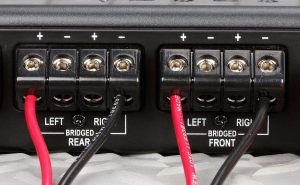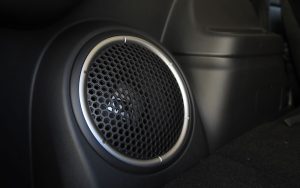If you’re an audiophile or a car enthusiast looking to elevate your in-car audio experience, you might have stumbled upon the term “passive subwoofer.” But what exactly is a passive subwoofer, and how can it transform your car stereo setup? In this comprehensive guide, we’ll dive into the world of passive subwoofers, sharing personal experiences and shedding light on the crucial EQ settings that can make all the difference.
Table: Features of a Passive Subwoofer
| Feature | Description |
| Power Handling | How much power the subwoofer can handle without distortion, measured in watts. |
| Impedance | The resistance the subwoofer presents to the amplifier, measured in ohms. |
| Size | The physical dimensions of the subwoofer, influencing where it can be installed in your car. |
| Frequency Response | The range of frequencies the subwoofer can reproduce, crucial for deep and impactful bass. |
| Enclosure Type | Whether the subwoofer is designed for sealed or ported enclosures, affecting its sound characteristics. |
| Sensitivity | How efficiently the subwoofer converts power into sound, influencing its overall performance. |
Contents
The Passive Subwoofer Experience
As a devoted user of a passive subwoofer in my car audio system, the impact it has had on my listening pleasure is undeniable. Unlike active subwoofers that have built-in amplifiers, passive subwoofers rely on an external amplifier to deliver that deep, resonating bass.
Choosing the Right Power:
One of the critical aspects of harnessing the true potential of a passive subwoofer lies in matching it with an amplifier that provides the right amount of power. Too little, and the subwoofer might not deliver the desired punch; too much, and you risk damaging the speaker. Finding that sweet spot ensures a powerful and distortion-free bass experience.
Understanding Impedance:
Impedance plays a pivotal role in the compatibility between the subwoofer and the amplifier. Ensuring that your subwoofer’s impedance matches the amplifier’s requirements prevents overheating and ensures optimal performance. It’s like finding the perfect partner – compatibility is key.
Size Matters:
The size of your passive subwoofer can significantly impact the overall sound quality. Larger subwoofers generally produce deeper bass, but it’s crucial to choose a size that fits seamlessly into your car without sacrificing precious space. Striking the right balance ensures a harmonious integration into your car’s audio system.
Mastering the Frequency Response:
A passive subwoofer’s frequency response determines the range of tones it can reproduce. For bass lovers, a wider frequency response is desirable, providing a fuller and more immersive audio experience. Tailoring the frequency response to your musical preferences ensures that every beat is felt, not just heard.
Enclosure Type and Sensitivity:
Selecting the appropriate enclosure type for your passive subwoofer – sealed or ported – influences the character of the bass produced. Sealed enclosures offer tight and accurate bass, while ported enclosures emphasize a more boomy, resonant sound. Sensitivity, on the other hand, measures how efficiently the subwoofer converts power into sound, affecting its overall performance. Finding the right balance between enclosure type and sensitivity ensures the bass complements your preferred music genres.
Fine-Tuning with EQ Settings
Once your passive subwoofer is seamlessly integrated into your car audio system, the next step is fine-tuning with EQ settings. Experimenting with the equalizer allows you to customize the sound to your liking, ensuring that the bass is not overpowering or lacking. Pay attention to the low-frequency range and adjust accordingly – a subtle tweak can make a world of difference.
Popular Models of Passive Subwoofers: Unveiling the Best in Bass
1. Rockford Fosgate P3D2-12 Punch Series: Known for its powerful performance and durability, this subwoofer boasts a high power handling capacity, making it a top choice for car audio enthusiasts.
2. JL Audio 10W6v3-D4: Renowned for its exceptional sound quality, the JL Audio 10W6v3-D4 features a dual voice coil design and advanced technology, delivering deep, precise bass.
3. Kicker 44CWCS124 CompC Series: A budget-friendly yet high-performing option, the Kicker 44CWCS124 is praised for its versatility and ability to reproduce clear and impactful bass frequencies.
4. Pioneer TS-W3003D4 Champion Series: Pioneer’s Champion Series is a favorite among users seeking a perfect blend of power and reliability. The TS-W3003D4 offers a robust design and impressive frequency response.
5. Alpine Type-R SWR-12D2: Renowned for its cutting-edge engineering, the Alpine Type-R SWR-12D2 features dual 2-ohm voice coils and delivers a balanced and precise bass response that audiophiles appreciate.
6. MTX Audio Terminator TNE212D: The MTX Audio Terminator TNE212D is a popular choice for those seeking an all-in-one solution. This dual subwoofer enclosure is praised for its affordability and ease of installation.
Conclusion
In the world of car audio enthusiasts, a passive subwoofer is more than just a component – it’s a gateway to a richer, more immersive driving experience. From understanding the key features to mastering EQ settings, the journey to optimal bass performance is both rewarding and transformative. So, gear up, tune in, and let the power of a passive subwoofer redefine your car stereo adventure.
FAQs: Unraveling the Mysteries of Passive Subwoofers
1. What exactly is a passive subwoofer?
A passive subwoofer is a type of speaker that is designed to reproduce low-frequency sounds or bass. Unlike active subwoofers that have a built-in amplifier, passive subwoofers rely on an external amplifier to provide power and drive the speaker.
2. How do I choose the right power for my passive subwoofer?
Choosing the right power for your passive subwoofer involves matching it with an amplifier that delivers an appropriate amount of power. Check the subwoofer’s power handling specifications and ensure that the amplifier can provide sufficient power without causing distortion.
3. Why is impedance important for passive subwoofers?
Impedance is crucial for ensuring compatibility between the subwoofer and the amplifier. Matching the impedance prevents issues such as overheating and ensures that the subwoofer operates optimally, delivering the desired bass response.
4. What size of passive subwoofer is ideal for my car?
The size of the passive subwoofer depends on personal preferences and available space in your car. Larger subwoofers generally produce deeper bass, but it’s essential to choose a size that fits seamlessly into your vehicle without compromising comfort or storage space.
5. How does the enclosure type affect the sound of a passive subwoofer?
The enclosure type, whether sealed or ported, significantly influences the character of the bass produced. Sealed enclosures offer tight and accurate bass, while ported enclosures emphasize a more resonant and sound. Selecting the right type depends on your musical preferences.
6. Can I fine-tune the sound of my passive subwoofer with EQ settings?
Yes, fine-tuning with EQ settings is a crucial step in optimizing the performance of your passive subwoofer. Experiment with the equalizer to customize the sound according to your preferences, focusing on the low-frequency range to achieve the perfect balance without overpowering or underwhelming the bass.






